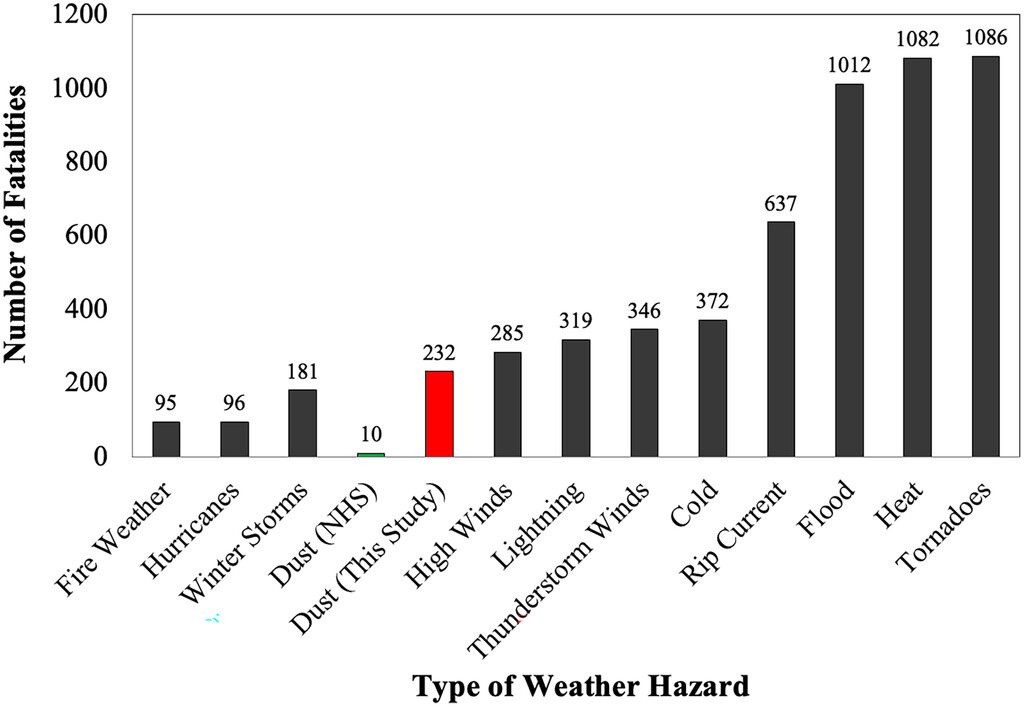Driving in stormy weather is hard enough, but driving during a dust storm or a haboob could be even more deadly.
NOAA’s Air Resources Laboratory has new research on the link between dust storms and fatal crashes in the United States.
The dust storm phenomenon is mostly underreported when it comes to deadly accidents, so a group of NOAA researchers took on the task to help us understand dust storms and get more data. Learn about it in the video above.
A dust storm is massive walls of dust and sand that are blown into the area by strong winds.
They can happen in seconds and become a mile long and/or thousands of feet high, shrouding you in a cloud of dust. These storms reduce your visibility, making it difficult to drive, which could lead to car accidents.
“We were trying to quantify how many dust storm deaths there were, but then found that dust storm deaths were being underreported and misrepresented by the Natural Hazard Statistics (HazStats), which is the most public facing data source for these kinds of things. So, we wanted to find what the actual numbers were given the limited data we have,” said Irene Feng, a graduate student at George Mason University and one co-authors of the study.
The scientists cross-referenced and compiled data from NOAA’s Storm Events Database and HazStats and the U.S. Department of Transportation’s National Highway Traffic Safety Administration’s Fatality Analysis Reporting System (FARS).
They found that dust storms cause more crashes than previously recorded. Between 2007 and 2017, dust storms caused 232 deaths. That’s higher than the fatalities from fire weather (95), hurricanes (96) and winter storms (181) during that time.

The University of Texas at El Paso professor and co-author Thomas Gill told me “we found out that dust was a factor in highway crashes nationwide, not just in the deserts of the Southwest and the former Dust Bowl region of the Plains.”
Professor Gill said their research also identified the Corn Belt as a dust hazard zone, too. Those findings came many months before the tragic series of crashes in Illinois.
In May 2023, a dust storm caused a deadly pileup in Divernon, Illinois. Eight people died and over 70 people became injured when blowing dust from a plowed, open farm field caused a traffic accident in the rural town.
“Many dust storms are caused directly or indirectly by human activities, from agricultural practices on farmlands, to diverting the water supply away from desert lakes causing them to dry up into dusty lake beds,” said Gill.
Lead author and George Mason University professor Daniel Tong says climate change and drought will influence the frequency and severity of dust storms too.
“In the Western U.S., water, drought and dust are closely linked. As warming climate and expanding drought make water supplies more precious, vegetation dies back exposing more bare ground that can give off dust,” Tong told me.
Through their research, the team also found that dust storms are undercounted too. Feng says there are many reasons this is the case.
“For one, not all dust storm events are categorized in the NOAA Storm Data. Often, they will be categorized as a high wind event or a thunderstorm wind event instead. The National Weather Service’s [HazStats] only counts 'direct deaths' from weather events.
"Most of the dust related deaths are counted as 'indirect deaths' because they cause fatalities through decreased visibility rather than say, directly suffocating from the dust,” she said.
Tong recommends accuracy in dust storm accounting could become improved by weather agencies and law enforcement working together during and after these events and weather databases offering multiple classifications for a weather event.
Our team of meteorologists dives deep into the science of weather and breaks down timely weather data and information. To view more weather and climate stories, check out our weather blogs section.




